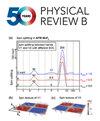Finite-size topological phases from semimetals
IF 3.7
2区 物理与天体物理
Q1 Physics and Astronomy
引用次数: 0
Abstract
Topological semimetals are some of the topological phases of matter most intensely studied experimentally. The Weyl semimetal phase, in particular, has garnered tremendous, sustained interest given fascinating signatures such as the Fermi arc surface states and the chiral anomaly, as well as the minimal requirements to protect this three-dimensional (3D) topological phase. Here, we show that thin films of Weyl semimetals [which we call quasi-(3−1)-dimensional, or q(半金属的有限尺寸拓扑相
拓扑半金属是实验研究最多的物质的拓扑相。特别是Weyl半金属相,由于具有迷人的特征,如费米弧表面态和手性异常,以及保护这种三维(3D)拓扑相的最低要求,已经获得了巨大的,持续的兴趣。在这里,我们表明Weyl半金属薄膜[我们称之为准(3−1)维,或q(3−1)D]一般实现有限尺寸的拓扑相不同于已建立的分类方案的3D和2D拓扑相:3D体拓扑的响应特征与拓扑保护,准(3−2)D费米弧态或手性边界模式共存,这是由于第二种先前未识别的体边界对应。我们在实验中证明了这些有限尺寸的拓扑半金属相是由哈密顿量捕获的少层范德华材料MoTe2的费米学实现的。鉴于对少层范德华材料和拓扑半金属的广泛实验兴趣,我们的工作为未来广泛的有限尺寸拓扑相的理论和实验表征铺平了道路。2025年由美国物理学会出版
本文章由计算机程序翻译,如有差异,请以英文原文为准。
求助全文
约1分钟内获得全文
求助全文
来源期刊

Physical Review B
物理-物理:凝聚态物理
CiteScore
6.70
自引率
32.40%
发文量
0
审稿时长
3.0 months
期刊介绍:
Physical Review B (PRB) is the world’s largest dedicated physics journal, publishing approximately 100 new, high-quality papers each week. The most highly cited journal in condensed matter physics, PRB provides outstanding depth and breadth of coverage, combined with unrivaled context and background for ongoing research by scientists worldwide.
PRB covers the full range of condensed matter, materials physics, and related subfields, including:
-Structure and phase transitions
-Ferroelectrics and multiferroics
-Disordered systems and alloys
-Magnetism
-Superconductivity
-Electronic structure, photonics, and metamaterials
-Semiconductors and mesoscopic systems
-Surfaces, nanoscience, and two-dimensional materials
-Topological states of matter
 求助内容:
求助内容: 应助结果提醒方式:
应助结果提醒方式:


